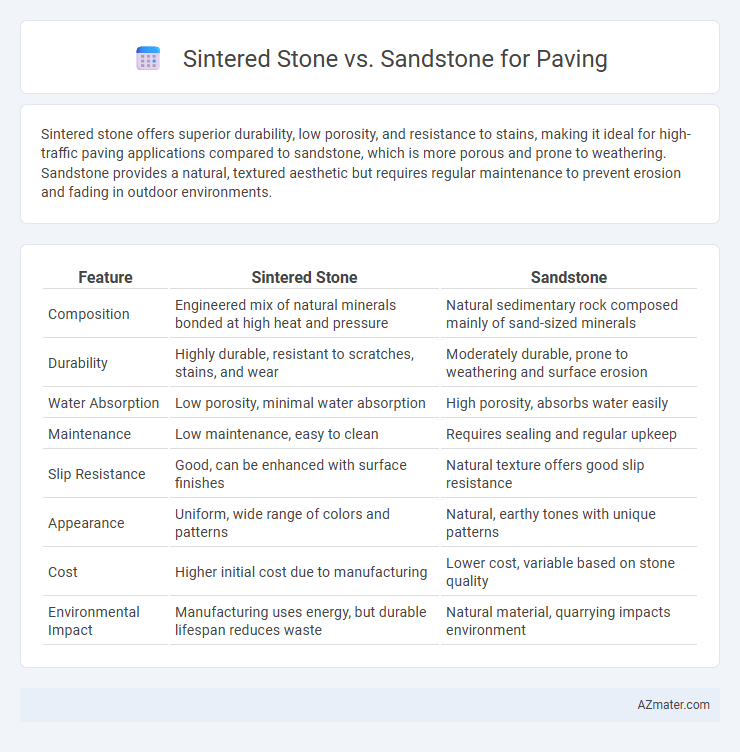Sintered stone offers superior durability, low porosity, and resistance to stains, making it ideal for high-traffic paving applications compared to sandstone, which is more porous and prone to weathering. Sandstone provides a natural, textured aesthetic but requires regular maintenance to prevent erosion and fading in outdoor environments.
Table of Comparison
| Feature | Sintered Stone | Sandstone |
|---|---|---|
| Composition | Engineered mix of natural minerals bonded at high heat and pressure | Natural sedimentary rock composed mainly of sand-sized minerals |
| Durability | Highly durable, resistant to scratches, stains, and wear | Moderately durable, prone to weathering and surface erosion |
| Water Absorption | Low porosity, minimal water absorption | High porosity, absorbs water easily |
| Maintenance | Low maintenance, easy to clean | Requires sealing and regular upkeep |
| Slip Resistance | Good, can be enhanced with surface finishes | Natural texture offers good slip resistance |
| Appearance | Uniform, wide range of colors and patterns | Natural, earthy tones with unique patterns |
| Cost | Higher initial cost due to manufacturing | Lower cost, variable based on stone quality |
| Environmental Impact | Manufacturing uses energy, but durable lifespan reduces waste | Natural material, quarrying impacts environment |
Introduction to Sintered Stone and Sandstone
Sintered stone is an engineered material composed of natural minerals fused under extreme heat and pressure, offering superior durability and resistance to stains, scratches, and weathering. Sandstone is a natural sedimentary rock formed from compacted sand grains, known for its unique textures and warm, earthy tones but generally less resistant to wear and moisture compared to sintered stone. Both materials are popular choices for paving, with sintered stone favored for modern, low-maintenance applications and sandstone prized for its natural aesthetic and historic charm.
Composition and Manufacturing Processes
Sintered stone is engineered using a high-pressure and high-temperature process that fuses natural minerals such as quartz, feldspar, and kaolin into a dense, non-porous surface, offering superior durability compared to traditional sandstone. Sandstone is a sedimentary rock composed mainly of sand-sized mineral particles, primarily quartz and feldspar, formed through natural sedimentation and cementation over time, resulting in a more porous and softer texture. The manufacturing process of sintered stone involves advanced technological methods that enhance hardness and resistance to weathering, making it ideal for paving, whereas sandstone's natural formation limits its strength and longevity in high-traffic outdoor applications.
Aesthetic Differences and Design Options
Sintered stone offers a sleek, uniform surface with a wide spectrum of colors and patterns that mimic natural materials, providing modern design flexibility ideal for contemporary paving projects. Sandstone features a more rustic and textured appearance, with natural variations and earthy tones that enhance traditional or organic outdoor spaces. The choice between sintered stone and sandstone impacts aesthetic outcomes, as sintered stone supports seamless, minimalistic designs while sandstone contributes character and variation through its distinctive grain and weathered look.
Durability and Strength Comparison
Sintered stone exhibits superior durability and strength compared to sandstone due to its manufacturing process, which involves high heat and pressure to fuse natural minerals into a dense, non-porous material. Sandstone, a sedimentary rock, is more prone to weathering and erosion, leading to reduced longevity in high-traffic or harsh weather conditions. The high compressive strength of sintered stone makes it an ideal choice for paving applications demanding resilience against heavy loads and abrasion.
Water and Stain Resistance
Sintered stone offers superior water and stain resistance compared to sandstone, making it ideal for paving in wet or heavily trafficked areas. Its non-porous surface prevents water absorption and resists staining from oils, dirt, and chemicals, ensuring long-term durability. Sandstone, being more porous, tends to absorb moisture and stains, requiring regular sealing to maintain its appearance and structural integrity.
Installation Considerations
Sintered stone offers superior durability and requires minimal sealing, making it easier to install with thin-set adhesives compared to sandstone, which demands a more careful base preparation due to its natural porosity and susceptibility to moisture absorption. Sandstone paving often necessitates additional joint reinforcement and frequent sealing to prevent weathering and staining, increasing installation time and maintenance. Sintered stone's consistent thickness and density enable faster, more precise cutting and fitting, optimizing labor efficiency during the paving process.
Maintenance and Cleaning Requirements
Sintered stone offers exceptional resistance to stains, scratches, and weathering, requiring minimal maintenance compared to sandstone, which is more porous and prone to absorbing dirt and moisture. Cleaning sintered stone involves simple wiping with mild detergent and water, while sandstone often demands regular sealing and specialized cleaning agents to prevent damage and discoloration. Due to its durability and low porosity, sintered stone is ideal for high-traffic paving areas with reduced upkeep needs.
Environmental Impact and Sustainability
Sintered stone offers superior environmental benefits over sandstone for paving due to its production using recycled raw materials and lower water consumption, reducing its ecological footprint. Sandstone, while natural and biodegradable, often requires extensive quarrying that can lead to habitat disruption and higher energy use in extraction and processing. Choosing sintered stone contributes to sustainability through durability and minimal maintenance, extending pavement lifespan and reducing resource demand for replacements.
Cost Analysis and Long-Term Value
Sintered stone offers higher upfront costs compared to sandstone but delivers superior durability and minimal maintenance expenses, making it more cost-effective over time. Sandstone requires frequent sealing and can deteriorate faster under heavy traffic, increasing long-term repair and replacement costs. Evaluating initial investment against lifespan and upkeep, sintered stone provides greater long-term value for paving projects with high usage.
Choosing the Best Material for Your Paving Project
Sintered stone offers superior durability and resistance to weather, stains, and scratches compared to sandstone, making it ideal for high-traffic or harsh climate paving projects. Sandstone provides natural texture and warmth but requires regular sealing and maintenance to prevent erosion and fading under heavy use. Choosing between sintered stone and sandstone depends on balancing long-term performance with aesthetic preferences and maintenance commitment.

Infographic: Sintered stone vs Sandstone for Paving
 azmater.com
azmater.com